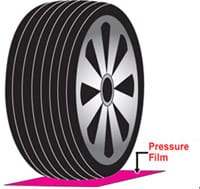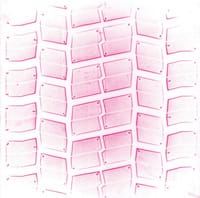The tread is the tire surface that contacts the road. Tire Tread Designs are arranged to meet specific market segments such as general purpose, mud and snow, high performance, etc. As shown in Figure 1, the tread pattern consists of ribs, tread blocks or lugs, grooves, and sipes. The ribs are solid elements that run along the circumference of the tire and contact the road. Tread blocks or lugs also make road contact. The grooves are needed to channel water away from the tire. Sipes are valleys cut across the lugs to allow water to escape to the shoulder (i.e., the tire side) to prevent hydroplaning.

Fig 1: Elements of a Tire Tread Pattern
Tire tread designs with small void ratios promote higher traction. Mud and snow tires have higher void ratios to channel away water and mud thereby providing better gripping performance. The tread is a thick rubber or composite rubber compound. It is formulated to provide an appropriate level of traction and wear. Harder rubber gives better wear; softer rubber, better traction. Tire tread designs feature non-uniform lug sizes to minimize noise levels.
Tire and auto manufacturers frequently need to evaluate the pressure or force between tires and roads. This can be accomplished using strain gauges and load cells, but both are time consuming and difficult to interface. However, using Fujifilm Prescale®, pressure indicating film, evaluating surface contact pressure distribution and magnitude is accurate, quick, and highly economical.
Fujifilm Prescale® is a Mylar-based film that contains a layer of tiny microcapsules. The application of force upon the film causes the microcapsules to rupture, producing an instantaneous and permanent high-resolution “topographical” image of pressure variation across the contact area.
Simply place Fujifilm Prescale® pressure indicating sensor film between any two surfaces that touch, mate or impact. Apply pressure, remove it and immediately the film reveals the pressure distribution profile that occurred between the two surfaces. Conceptually similar to Litmus paper, the color intensity of Fujifilm Prescale® is directly proportional to the amount of pressure applied to it. This is demonstrated in Figures 2–4.
 |  |  |
| Fig 2: Tire Placed on Fujifilm Prescale® Film | Fig 3: Fujifilm Prescale® Film Before Topaq® Analysis | Fig 4: Fujifilm Prescale® Film After Topaq® Analysis |


